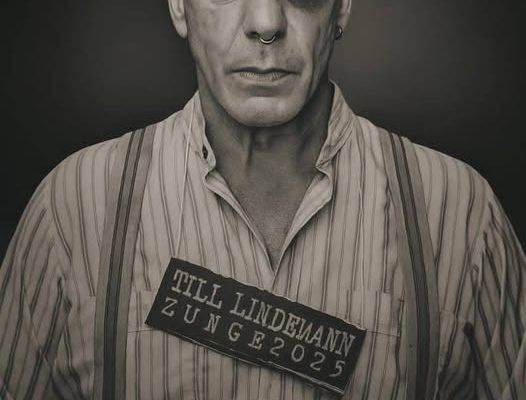When the opening credits of Netflix’s The Till Lindemann Untold Story blaze across the screen, accompanied by the haunting strains of “Mein Herz brennt,” viewers immediately know they are entering uncharted territory. This is not a mere rock documentary. It is an unflinching psychological excavation of one of the most enigmatic, polarizing, and misunderstood figures in modern music. Till Lindemann — the frontman of Rammstein — has long been a man of contradictions: a poet of pain, a provocateur of power, and an artist who lives on the razor’s edge between genius and madness. For decades, his voice has been the infernal thunder behind one of the world’s most incendiary bands. But as Netflix’s latest deep dive reveals, behind the pyrotechnics and the controversy lies a man shaped by trauma, discipline, and a lifelong obsession with the boundaries of art and humanity.
From the very first moments, the documentary dismantles the myth of Till Lindemann the monster and reconstructs the portrait of Till Lindemann the man. Born in East Germany in 1963, Lindemann’s early years were defined by silence and isolation. His father, a celebrated children’s poet, was emotionally distant; his mother, often absent. The film reconstructs this childhood through rare family photos and haunting voiceovers of Till reading his own poetry. It’s a startlingly tender beginning for a man whose stage persona is built on aggression and excess. “The child who wasn’t heard became the man who screamed,” one of his childhood friends says. It’s a quote that sets the emotional tone for everything that follows.
The documentary then shifts to the dawn of Rammstein — a band forged in the dying embers of the Cold War, born out of the raw industrial grit of East Berlin. Through interviews with bandmates, producers, and cultural historians, Netflix lays bare how the group’s distinct sound and theatricality became a rebellion against both political repression and Western conformity. For Lindemann, Rammstein was never just about music; it was performance as exorcism, stage as confessional. The flames, the latex, the violence — all of it, the film suggests, are manifestations of a deeply internal war.
And yet, The Till Lindemann Untold Story is not an apologia. It is not here to sanitize. The filmmakers refuse to shy away from the controversies that have defined Lindemann’s career — from allegations of misogyny and violence to the disturbing imagery in his lyrics and videos. Instead, the documentary confronts these shadows head-on, interweaving archival footage with present-day reflections from critics and psychologists. One sequence — set to the pounding rhythm of “Ich tu dir weh” — examines the interplay between pain, consent, and performance in Lindemann’s art. The scenes are raw, uncomfortable, but deeply illuminating. The central question emerges: where does performance end and reality begin?
What makes the film extraordinary is its refusal to simplify. Till Lindemann is neither hero nor villain here; he is both poet and predator, saint and sinner. His poetry, often overlooked outside German literary circles, becomes a focal point of the narrative. Passages from his books Messer and In Stillen Nächten are recited over abstract visual montages — images of fire, water, and decay. His words, stripped of music and spectacle, reveal a voice of surprising sensitivity. “I am a man of glass,” he writes in one poem. “Every look cuts through me.” It’s a revelation that redefines how we see him — not just as a performer drenched in blood and flames, but as a fragile artist wrestling with his own reflection.
Netflix takes viewers inside Lindemann’s creative process, revealing how meticulously he constructs Rammstein’s notorious live shows. There is method in the madness: every explosion is timed to the millisecond, every gesture calibrated to provoke both awe and discomfort. Former tour manager Emanuel Fialik describes the experience as “a symphony of chaos disguised as destruction.” Yet behind the scenes, Lindemann appears quiet, almost monk-like, obsessing over details, rewriting lyrics in solitude, sketching set designs by hand. His bandmates describe him as “a perfectionist haunted by imperfection.” It is this paradox — the serene mind behind the inferno — that forms the spine of the film.
The most emotional segment of The Till Lindemann Untold Story delves into his years as a competitive swimmer in East Germany, long before music consumed his life. Archival footage shows a young Till gliding through cold water, his expression stoic, focused, relentless. The discipline, the isolation, the punishing regime — these were the crucibles that shaped his psyche. When he suffered a career-ending injury, the devastation was total. That loss, several commentators suggest, became the origin of his obsession with control — an obsession that manifests in every aspect of his art. “He’s always fighting the water,” one teammate recalls. “Even now, it’s just that the water became fire.”
In a rare on-camera interview, Lindemann himself reflects on his dual nature. Speaking in his gravelly baritone, his words are both cryptic and candid: “People call me a monster because I show what they hide. I write about what everyone feels but no one wants to say.” It’s not justification; it’s confrontation. Netflix’s cameras linger on his face — lines etched deep, eyes weary yet alive. The man who once terrified audiences with flamethrowers now seems more introspective than infernal. The film doesn’t ask us to forgive him; it asks us to understand the cost of being Till Lindemann.
The documentary also explores the intense relationship between Lindemann and his audience. Concert footage from stadiums across the globe reveals something almost ritualistic — fans screaming, crying, transfixed. The fire, the spectacle, the danger — it’s catharsis on a mass scale. Sociologists interviewed in the film describe Rammstein concerts as “modern myth-making,” a communal release of repressed emotions. Lindemann’s role, they argue, is that of a shaman leading his followers through the darkness and back again. In a world obsessed with filters and moral binaries, his art offers something primal, even purifying.
But The Till Lindemann Untold Story isn’t afraid to challenge its own fascination. Late in the film, a journalist asks whether celebrating such darkness risks normalizing it. The question lingers, unanswered. The camera cuts to Lindemann walking alone by the Spree River at dawn, cigarette smoke curling into the gray Berlin air. The firestarter, now subdued, looks out over the water — reflective, almost remorseful. “I write about death,” he says quietly, “because I am afraid of dying.” It’s one of the documentary’s most devastating moments — a reminder that beneath the monstrous imagery lies a man terrified of his own mortality.
Netflix’s cinematography mirrors this duality: stark black-and-white interviews contrast with saturated bursts of color during concert sequences. The editing oscillates between order and chaos, mirroring Lindemann’s psyche. The score — a blend of Rammstein’s music and new minimalist compositions — underscores the emotional volatility. Every choice feels deliberate, designed to immerse the viewer in the psychological labyrinth of its subject.
As the documentary nears its conclusion, it shifts from analysis to meditation. We see Lindemann in solitude, writing in a dimly lit room, reading fragments of his poetry aloud. The words are hauntingly simple: “I am the fire and the ash. I am the wound and the knife.” There is no grand finale, no redemption arc — just a quiet acknowledgment that art, for Lindemann, is both salvation and self-destruction. The closing shot — a slow zoom into his weathered face as the final notes of “Sonne” fade — encapsulates the essence of the man: both blinding light and consuming darkness.



